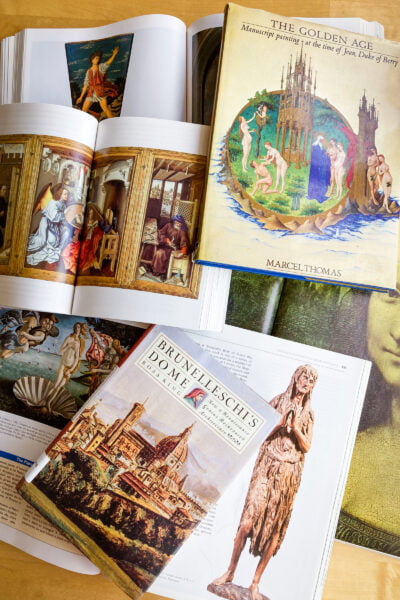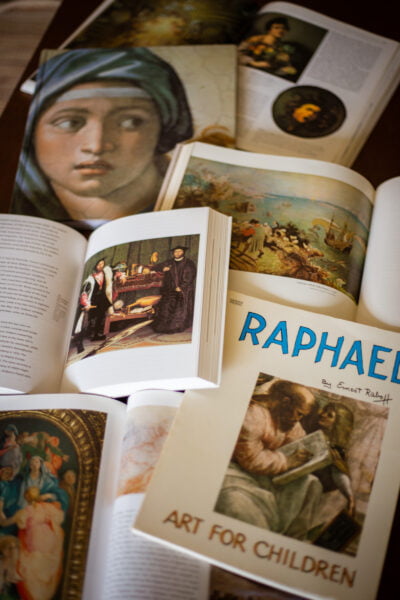25 Artists from the 1600s to Include in Your Picture Study Time

Over the last few months, I’ve been sharing lists of artists from the 1800s and the 1700s to include in your picture study time. Today, I’m sharing a list of some excellent options for picture study from the 1600s!
As I mentioned last month, these are certainly not the only ones to explore, nor is it necessary to include every single one. These are, however, some of the ones I’ve enjoyed learning more about either in my college classes or later on as I have pursued more art history knowledge on my own.
I’ve again tried to include a range of styles, nationalities, and perspectives; however, if you see an artist you feel should be listed here, feel free to leave a comment below!
The Artists
Caravaggio

Nationality: Italian
Movement: Baroque
Caravaggio (1571-1610) is such an enormous figure in art history that an entire school of artists, distinguished by their use of chiaroscuro, was named after him: Caravaggisti. Artists (including several on this list) imitated his style for years during his lifetime and after his early death. No list of artists from the seventeenth century would be complete without him.
Peter Paul Rubens

Nationality: Flemish
Movement: Baroque
Peter Paul Rubens (1577-1640) is another enormous figure in art history, so much so that his last name has been turned into an adjective describing the kinds of women he painted: “Rubenesque.” He painted scenes from both classical mythology as well as religious stories.
Juan Bautista Maíno

Nationality: Spanish
Movement: Baroque
Juan Bautista Maíno (1581-1649) was a master of color, and his paintings are bright and bold. In his later life, while painting the piece above, he became a Dominican friar (or Fray, which is sometimes put before his name), and most of his paintings are religious in nature.
Frans Hals

Nationality: Dutch
Movement: Baroque/Dutch Golden Age
Frans Hals (1582-1666) was a master of portraiture and was gifted in capturing the personality of his models. Sometimes portraits have the reputation of being stiff and impersonal, but his paintings of individuals and groups are lively and full of emotion.
Lan Ying

Nationality: Chinese
Movement: Ming Dynasty
Lan Ying (c. 1585-1664) was naturally gifted and produced many pieces throughout his lifetime. He is known mainly for landscapes, but he also painted people and scenes from nature.
Gerrit van Honthorst

Nationality: Dutch
Movement: Baroque/Dutch Golden Age
Gerrit van Honthorst (1592-1656) enjoyed playing with light in his pieces and is mainly known for his portraits, though he also produced paintings with religious and mythological subjects as well. (His “Adoration of the Shepherds” is included in my Advent Art Devotions Volume III, and his “Christ before the High Priest” is included in my Lenten Art Devotions Volume II.)
Georges de la Tour

Nationality: French
Movement: Baroque
Georges de la Tour (1593-1652) was another master of light, and many of his paintings are quiet compositions lit only by candlelight. His oeuvre includes many religious scenes.
Artemisia Gentileschi

Nationality: Italian
Movement: Baroque
Artemisia Gentileschi (1593-1656) is known for her many paintings that focus on women as the main subject and are somewhat biographical (though subtly) in nature. She also often used herself as a model. Her oeuvre includes religious and mythological subjects.
Nicolas Poussin

Nationality: French
Movement: Baroque/Classicism
Nicolas Poussin (1594-1665) is considered a Baroque painter, however, he incorporated classic elements in his work as well, so his style is unique for his time. His oeuvre comprises a wide range of genres, including religious, mythological, and landscape painting. He was also a significant influence on some of the giants of the eighteenth century, including David, Ingres, and Cézanne.
Chen Hongshou

Nationality: Chinese
Movement: Ming Dynasty
Chen Honshou (1598-1652) was a very popular artist during his lifetime, and his work includes landscapes, people, and scenes from nature (specifically flowers and birds).
Francisco de Zurbaran

Nationality: Spanish
Movement: Baroque
Francisco de Zurbaran (1598-1664) was also known as the “Spanish Caravaggio.” His oeuvre consists primarily of religious pieces, but he also painted historical subjects and still-lifes.
Gian Lorenzo Bernini

Nationality: Italian
Movement: Baroque
Bernini (1598-1680) potentially covers two areas of a Charlotte Mason education: picture (or sculpture) study and architecture. He is not only well-known for his beautiful and realistic sculptures, but he was also the architect behind the piazza in front of St. Peter’s Basilica in Rome (Piazza San Pietro). He is also responsible for several beautiful installations inside the basilica as well.
Anthony van Dyck

Nationality: Flemish
Movement: Baroque
Anthony van Dyke (1599-1641), despite being born in Flanders, is known for being highly influential in the world of portrait painting in England. His oeuvre consists primarily of portraits, but he also produced paintings with religious and mythological subjects. (His “Christ Healing the Paralytic” is included in my Lenten Art Devotions Volume II.)
Diego Velázquez

Nationality: Spanish
Movement: Baroque
Diego Velázquez (1599-1660) was the official portrait painter of Philip IV of Spain and therefore didn’t face many of the privations of other 17th-century painters. Las Meninas is considered his magnum opus and has scholars, historians, and museum-goers still debating aspects of it to this day. His work includes a wide range of subjects.
Matthias Stom

Nationality: Dutch (active in Italy)
Movement: Baroque/Dutch Golden Age
Matthias Stom (c. 1600-1652) was another artist highly influenced by the work of Caravaggio. He was born in the Netherlands/Flanders area but was mainly active in Italy. This is especially evident in the fact that his work does not include the characteristic humor of his northern European contemporaries but rather the more serious feel of the Italians.
Claude Lorrain

Nationality: French (active in Italy)
Movement: Baroque
Claude Lorrain (also known as simply “Claude” – c. 1600-1682) is known for his sweeping landscapes. Even though landscapes were ranked relatively low on the hierarchy of art, because he included figures in his paintings, Claude’s work is generally categorized as historical art.
Rembrandt van Rijn

Nationality: Dutch
Movement: Baroque/Dutch Golden Age
Rembrandt (1607-1669) left the world with at least 40 self-portraits (his students made others) and a visual timeline of his life. He is well-known even outside of the art world and is another figure who should not be omitted from lists of seventeenth-century artists. His oeuvre includes a wide range of subjects and plenty of options for picture study, including the above painting that was stolen from the Isabella Stewart Gardener Museum in 1990 and has not been recovered. (The above painting is included in my Lenten Art Devotions Volume II, and his “The Return of the Prodigal Son” is included in my Lenten Art Devotions Volume IV.)
Judith Leyster

Nationality: Dutch
Movement: Baroque/Dutch Golden Age
Judith Leyster (1609-1660) was well-known, well-paid, and respected by her peers during her lifetime. However, most of her work was attributed to other artists after her death. It wasn’t until the early 19th century that she gained acknowledgment. Her oeuvre includes musicians, children (sometimes the two combined), groups of happy people, and other (mostly) lighthearted scenes.
Bartolomé Esteban Murillo

Nationality: Spanish
Movement: Baroque
Bartolomé Esteban Murillo (1617-1682) was one of the most famous Spanish painters for many years and influenced many later artists. His work primarily consists of religious subjects, but he also painted many portraits of common people from his area. (His “The Marriage Feast at Cana” is included in my Lenten Art Devotions Volume II.)
Jan Steen

Nationality: Dutch
Movement: Baroque/Dutch Golden Age
Jan Steen (c. 1626-1679) was a master of genre painting and recorded scenes from everyday life in captivating ways. He also painted portraits, historical, and religious scenes as well.
Jacob van Ruisdael

Nationality: Dutch
Movement: Baroque/Dutch Golden Age
Jacob van Ruisdael (c. 1629-1682) was highly influential as a landscape artist, which is evident in the work of John Constable, J.M.W. Turner, and other 18th- and 19th-century artists. His oeuvre features a wide range of subjects, including seascapes, waterfalls, farmland, and cities.
Johannes Vermeer

Nationality: Dutch
Movement: Baroque/Dutch Golden Age
Johannes Vermeer (1632-1675) didn’t gain popularity until late in the 19th century, with many of his paintings credited to his peers before that time. Since then, however, his work has become highly sought after by collectors and museums, though his oeuvre is relatively small. He is known mainly for his very realistic paintings of domestic scenes. (His “The Marriage Feast at Cana” is included in my Lenten Art Devotions Volume II.)
Nicolaes Maes

Nationality: Dutch
Movement: Baroque/Dutch Golden Age
Nicolaes Maes (1634-1693), as with his contemporary, Johannes Vermeer, also painted highly detailed scenes from Dutch domestic life with a slightly different style. The facial expressions of his models are more in line with other Dutch and Flemish artists from the time period, and he is well-known for his portraits.
Yuan-Ji (Shitao)

Nationality: Chinese
Movement: Qing Dynasty
Yuan-Ji, or Shitao (among other names – 1642-1707), was an Individualist painter and poet of the Qing Dynasty who broke with the artistic traditions of his predecessors. He is known for his sweeping landscapes that incorporated his poetry.
Rachel Ruysch

Nationality: Dutch
Movement: Baroque/Dutch Golden Age
Rachel Ruysch (1664-1750) is considered one of the leading still-life painters of her time period. Her paintings are beautifully detailed and feature the characteristic dramatic lighting of the Baroque style.
I also wanted to mention Maria Sibylla Merian (1647-1717) who was not a painter of specific scenes, landscapes, or portraits but instead painted detailed scientific studies. She is very popular in the Charlotte Mason world, especially for nature study.
And now I’m curious – who is your favorite 17th-century artist?
Other posts in this series:














